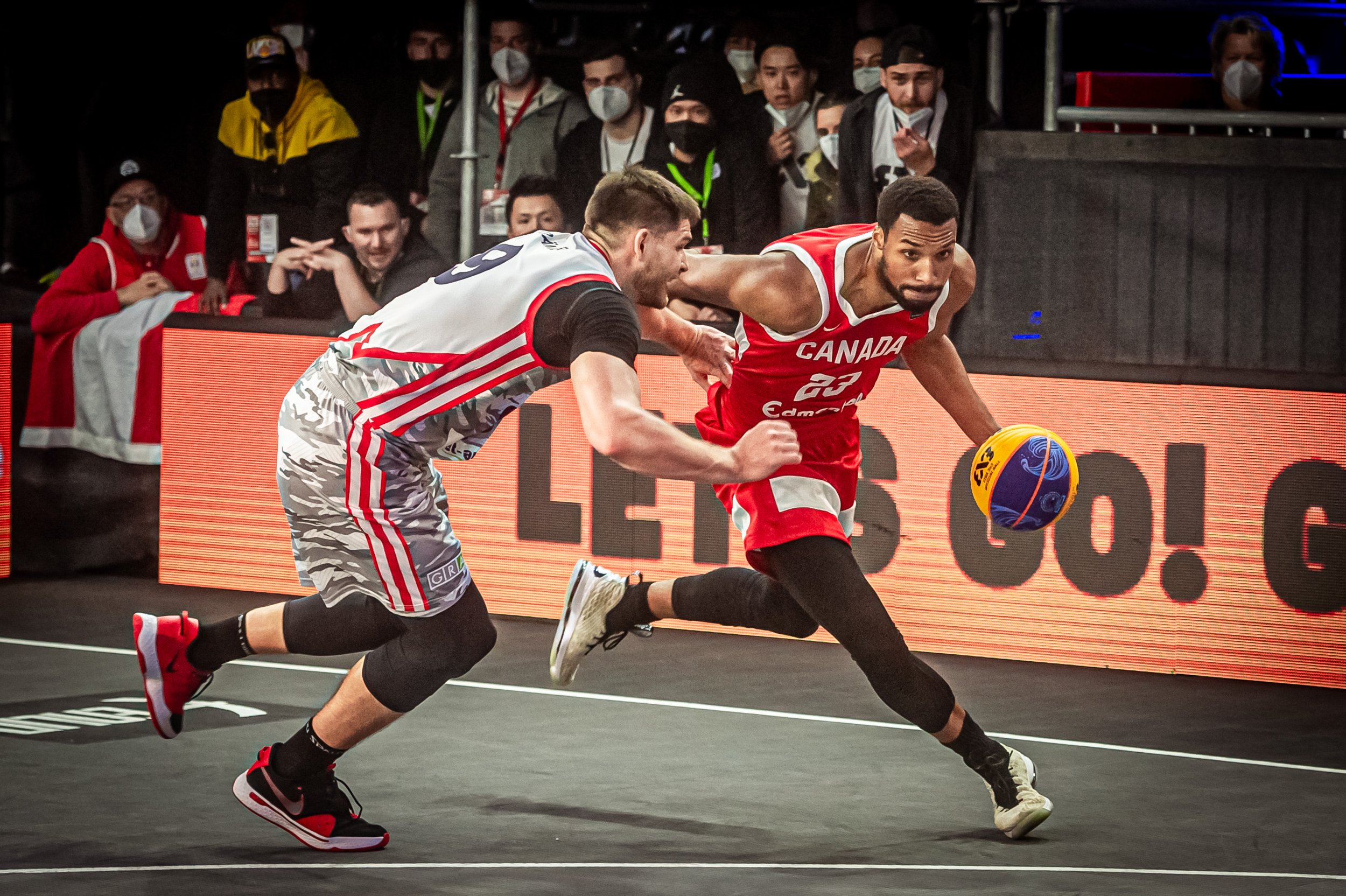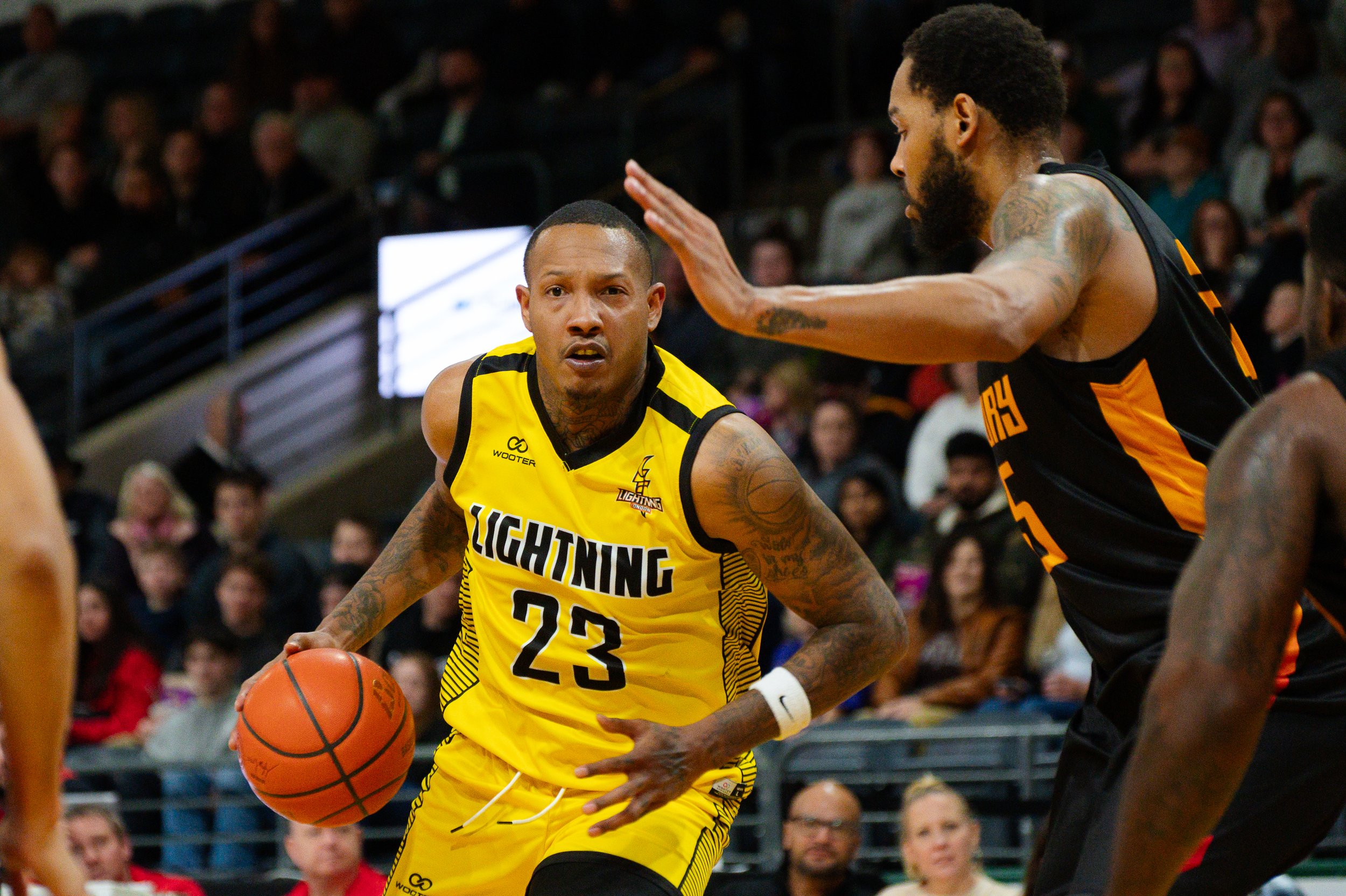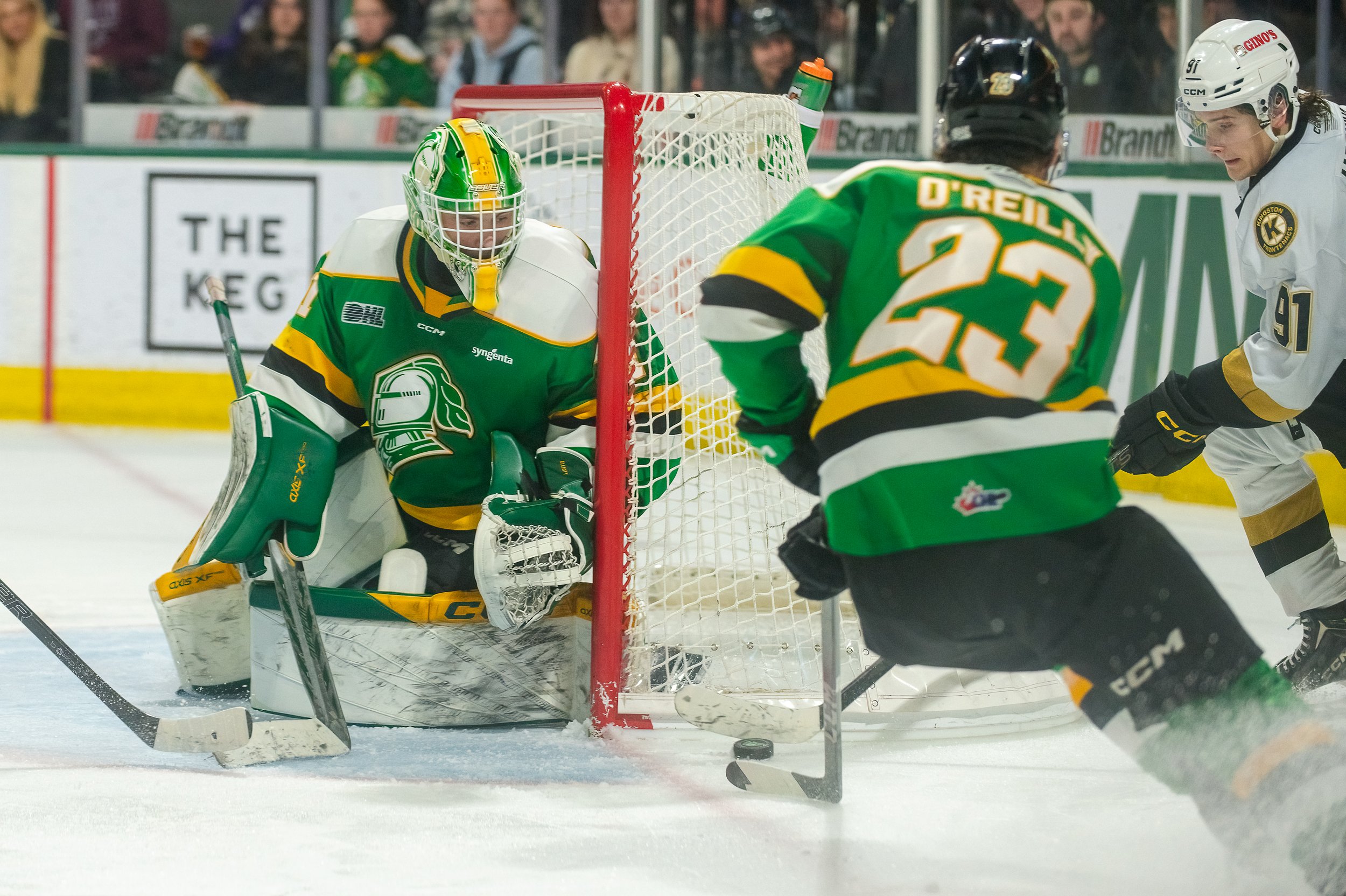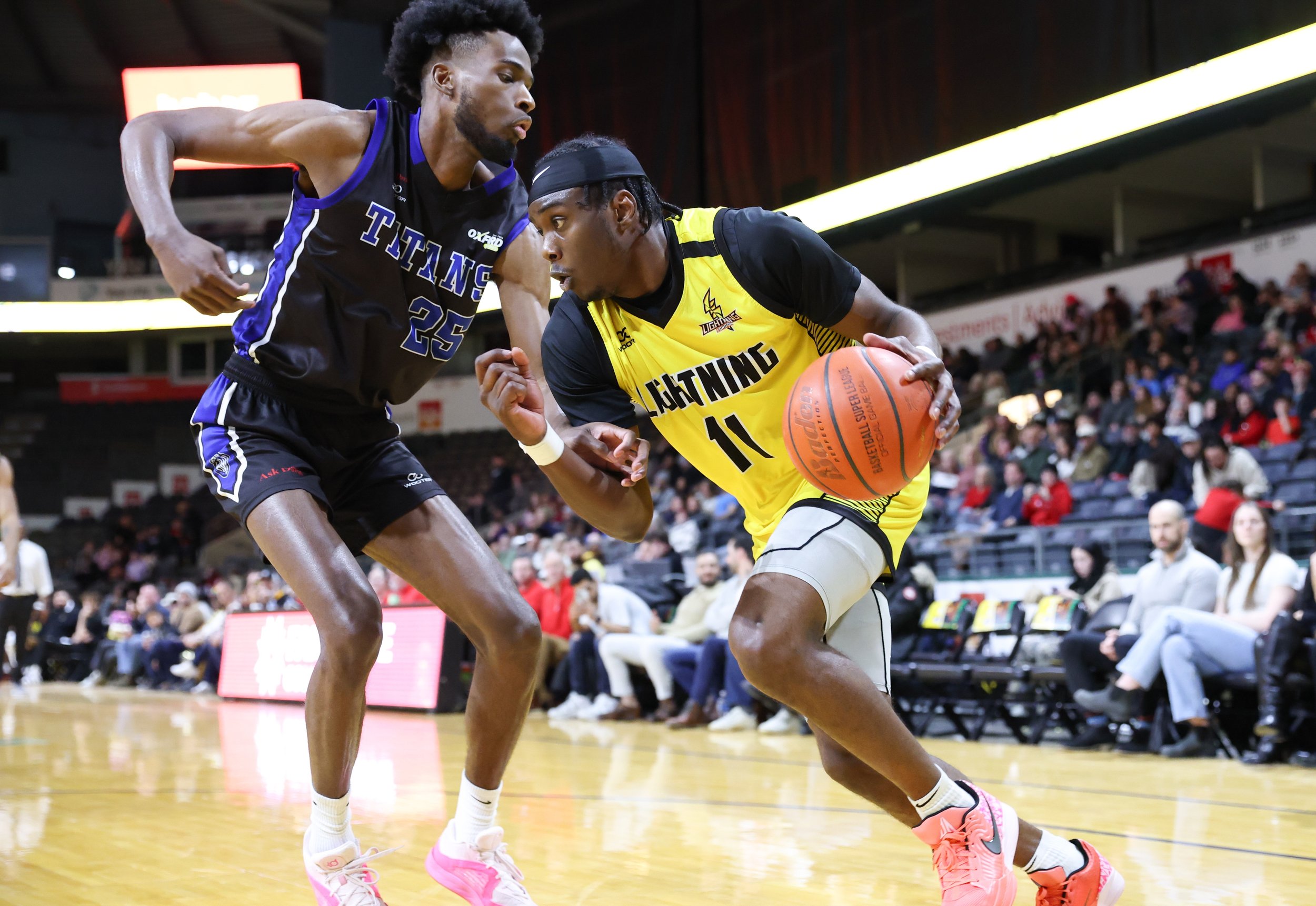Lightning forward brings a fresh take on an old game
A 3x3 player the last few years, including with Team Canada, Jordan Jensen-Whyte is excited to see what he can do back on the full court — with the Lightning — in a reunion with Coach Plumb.
(Photo: FIBA / Canada Basketball).
Step back to 2013. University of British Columbia. War Memorial Gymnasium.
Doug Plumb. vs. Jordan Jensen-Whyte. One-on-one.
Who do you put your money on?
“You know, as a competitor, I gotta say myself,” the London Lightning guard laughed when considering a matchup against his former teammate and now head coach. “But Doug was a hell of a player back in 2013. He’s one of the toughest players I’ve ever played against in my life. He’s one of those guys that you hit him and he’s just gonna keep going through you. He could get to the hoop pretty much any way he wanted, created a lot of opportunities for others. He could go left stronger than most guys, and he shot really, really well.
“But honestly, the biggest skill was his ability to lead. Without him on that team, we don’t win Canada West. The whole thing just doesn’t operate without him as a leader on that team. His attitude towards the opponents was that he didn’t care who we’re playing against, he was more focused on what we were supposed to be doing. He had it all. He had the full package in 2013.”
In December, Jensen-Whyte signed with the 2022 Bolts – for a three-peat reunion with Plumb, who was a teammate on that 2012-13 USPORTS Final 8 Thunderbirds squad, and an assistant coach with the St. John’s Edge during Jensen-Whyte’s abbreviated NBL Canada debut in 2017-18.
Now, the 6-foot-6 forward continues his “unique basketball journey” in the Forest City with a return to the league – bringing with him a whole new outlook on basketball and life beyond.
But before we get to his story, who did you say wins that one-on-one matchup with your coach, Jordan?
“OK, when I think about it, Doug probably would get me in 2013. Now, if you ask me that about today, that’s a whole different story …”
* * *
Only nine games into his professional career, Jensen-Whyte had no idea what would happen next.
The Calgary native was already contributing to his new team, averaging nearly 14 minutes a game in the Edge’s inaugural season when it all came crumbling down in December 2017.
“I was on the ground in quite a bit of pain. When I got taken off the floor, I didn’t know that I had torn my ACL yet, but I had a feeling,” he said of that moment in front of a home crowd against the visiting Lightning. “When I got the news from the doctor, I broke down in tears. It was pretty shattering for me. I was 23 at the time, and my career was just getting ready to start. I felt I got pushed back a little bit. It was a tough start to my career.
“That was also a pretty big eye-opener for me in terms of life. Basketball had played such a large role in everything that I had done up to that point, and to have that taken away from me for an extended period of time, it opened my eyes to a lot of things about what I wanted to do post-basketball.”
(Photo: FIBA / Canada Basketball).
Fresh out of UBC, Jensen-Whyte resisted the urge some athletes feel to fly through rehab, pushing an estimated yearlong timetable by as much as three months. Though heart-broken, he also wanted to have healthy knees, ones that would allow him to complete again and, more importantly, walk pain-free for the rest of his life. He prioritized making sure that the knee was 100% before he even thought about stepping back on the floor.
A high-level athlete is rarely afforded the luxury of time away from their sport, but Jensen-Whyte didn’t spend it wondering ‘what if.’ With the help of his family, he focused on ‘what’s next.’
“The best part that came out of that time was the reflection I was able to do.”
At UBC, Jensen-Whyte graduated with a degree in sociology, although he was uncertain what he wanted to do with it. In that year of rehabbing, he also went back to the University of Calgary and enrolled in a few law courses.
“I took a little bit of a break from basketball. I didn’t even want to think about it. My knee was messed up and I wanted to get back to normal, but I didn’t want to push it too hard or too fast and reinjure myself. I pulled my mind away from the game for a little while. In those law courses, I found something I liked. Since then, I’ve been working towards that.”
That means a post-basketball career where he hopes to continue working with athletes from the legal sidelines as an agent or lawyer.
“It was great to find a passion for something outside of the game, and one I want to integrate with the game whenever my time on the floor comes to an end. That injury led to a tremendous few years of growth for me.”
* * *
Jensen-Whyte is built different. To understand how, we need to talk about 3x3 for one second.
Once the dominant game on playgrounds around the world, 3x3 basketball took off within the last 20 years once FIBA, the sport’s governing body, created a structured system for the game, including the FIBA 3X3 World Tour and FIBA 3X3 World Cup. While traditional 5x5 basketball has been part of the Olympic games since 1936, men’s and women’s 3x3 basketball made its debut at the Tokyo Olympics last year with Latvia bringing home the men’s gold.
It’s largely the basketball game you think you know – but there are some rule changes that make the game just different enough:
Teams of four with three on the court at any one time play a half-court game with a smaller ball. Teams get one point for a basket inside the arc, two beyond. Played with a 12-second shot clock, games run 10 minutes of game time (or first to 21 points). After each basket, the opposition in-bounds the ball. On a possession change, the ball must be taken outside the arc before scoring.
Defensively, it’s a game where players need to hold their own. If they can’t, they’re going to get exposed throughout the game. Once a team figures out who the weak link is on the defensive end, they attack. Over and over. Only team fouls are tallied, with each foul resulting in a single free throw until the seventh foul, which then results in two free throws and possession.
“The pace of the game is a lot different,” Jensen-Whyte said. “It’s almost like hockey shifts, in that you go in, go really hard for a minute at a time, and then you’re gassed and come out. It’s a more physical game, and a faster game, where the officiating lets a lot more stuff go. You have to be able to play through a tremendous amount of contact, which takes not only a physical toll on your body, but also a mental toll.”
Handling contact is key, and when combined with the pace of play, there is no time for players to focus on the distractions that come with the ebb and flow of the game.
“If you're focused on other things outside the game, things get away from you. Fast. For example, if I go to the hoop and get hacked by someone, and I look over at the ref and complain, I have to bring myself back in as quickly as possible, because the game is so short. You can’t focus on the other external factors that are going on with the game.”
While Canada did not make the Olympic cut, Jensen-Whyte, along with teammates Alex Johnson, Kyle Landry, and Steve Sir, also played together as Team Edmonton on the FIBA 3x3 World Tour. It was a wild ride, Jensen-Whyte says, with hectic travel taking them to more than a dozen countries in the last few years, often for quick stops to play a tourney and then off to the next.
In 3x3, Jensen-Whyte found a game he enjoyed, one with similarities that far outnumber the differences when it comes to the style of play and skills involved in the 5x5 game. Modern basketball offenses are geared around ball-screen action, with three men in action and two spacers – 3x3 just eliminates the guys standing around.
(Photo: FIBA / Canada Basketball).
“I was always more of a guard, a primary ballhandler making decisions with the ball. I grew a lot in 3x3, especially with off-the-ball stuff like setting and angling screens. There’s so much more off-the-ball movement that I learned from those guys,” he explained.
“3x3 is a very structured setting. It may look chaotic, but the top teams in the world are running offenses. Learning how to play away from the ball is extremely important. The best teams find a way to create offense with the minimal amount of energy used. So, instead of trying to be the guy going one-on-one with the ball, how can the two guys away from the ball create an advantage so that it’s easier for the guy with the ball to score.”
Jensen-Whyte loved the philosophy of Europeans who play ‘team basketball’ which asks one question: How can we, as one unit, put that ball through the hoop and save energy while doing it?
Returning to the 5x5 game doesn’t so much pose a challenge for Jensen-Whyte, he’s more intrigued by what he’ll be able to accomplish.
“I’m really excited to see how that experience is going to translate back into 5x5,” he said. “I’ve developed in a different way than most players have. I’ve developed in a setting that’s not of the norm, and I’m excited to see what I can do back on the floor.”
* * *
Even as the NBL Canada worked to shape its 2022 season amid ever-shifting provincial guidelines, Jensen-Whyte diligently trained over the summer, keeping his body in shape for an opportunity to play.
And while this season may not get an answer to that one-on-one game against Plumb, Jensen-Whyte has plenty left to prove.
“I’m a really motivated individual, a self-motivated individual. I knew an opportunity was going to come at some point,” he said. “I’ve been grinding every day, doing the best I can to stay ready for the opportunity. When I got the word that the league was going to run, and Doug and the Lightning reached out, it was a really exciting day for me because I had an idea of what was going to happen next for my career.”












Around the Perimeter: London set for one-game playoff in New York. Winner moves on to semi; Coach Williams believes he’s found the right mix; Can Lightning conquer the Jackals’ den? …